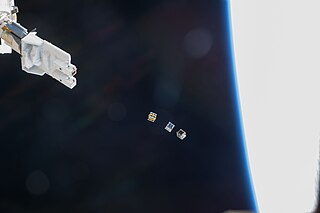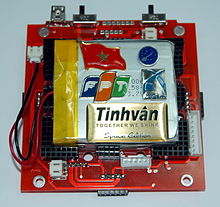
A CubeSat is a class of small satellite with a form factor of 10 cm (3.9 in) cubes. CubeSats have a mass of no more than 2 kg (4.4 lb) per unit, and often use commercial off-the-shelf (COTS) components for their electronics and structure. CubeSats are deployed into orbit from the International Space Station, or launched as secondary payloads on a launch vehicle. As of December 2023, more than 2,300 CubeSats have been launched.
RAIKO is a Japanese satellite which was built and operated by Tohoku and Wakayama Universities. A two-unit CubeSat, RAIKO was deployed from the International Space Station (ISS) on 4 October 2012, having been launched on 21 July 2012.
MaSat-1 is the first indigenous Hungarian satellite, developed and built by students at the Technical University of Budapest. The 1U CubeSat-type satellite was launched into low Earth orbit on 13 February 2012. The satellite provided telemetric data as well as VGA resolution color images at the 70 cm amateur radio wavelength received at the tracking center at Budapest. The center was tested on 31 March 2009 with the help of Charles Simonyi on board the International Space Station. With the successful launch of MaSat-1, Hungary became the 47th nation to orbit a satellite. Between 9 and 10 January 2015, the satellite reentered into the atmosphere.
ITUpSAT1, short for Istanbul Technical University picoSatellite-1, is a single CubeSat built by the Faculty of Aeronautics and Astronautics at the Istanbul Technical University. It was launched on 23 September 2009 atop a PSLV-C14 satellite launch vehicle from Satish Dhawan Space Centre, Sriharikota, Andhra Pradesh in India, and became the first Turkish university satellite to orbit the Earth. It was expected to have a minimum of six-month life term, but it is still functioning for over two years. It is a picosatellite with side lengths of 10 centimetres (3.9 in) and a mass of 0.990 kilograms (2.18 lb).
Technology Education Satellite (TechEdSat) is a successful nano-sat flight series conducted from the NASA Ames Research Center in collaboration with numerous universities. While one of the principal aims has been to introduce young professionals and university students to the practical realm of developing space flight hardware, considerable innovations have been introduced. In addition, this evolving flight platform has tested concepts for Low Earth Orbit (LEO) sample return, as well as planetary nano-sat class mission concepts.

WE WISH was a small commercial CubeSat which was deployed from the International Space Station (ISS) in October 2012 and which deorbited in March 2013. It was built by the Japanese technology company Meisei Electric and the Meisei Amateur Radio Club, and could transmit pictures taken by a small infrared camera via radio at 437.515 MHz. WE WISH travelled to orbit aboard Kounotori 3 (HTV-3) on 21 July 2012, along with other CubeSats including RAIKO, FITSAT-1, F-1, and TechEdSat-1.

The Nanoracks CubeSat Deployer (NRCSD) is a device to deploy CubeSats into orbit from the International Space Station (ISS).

Kounotori 7 (こうのとり7号機), also known as HTV-7, was the seventh flight of the H-II Transfer Vehicle (HTV), an uncrewed cargo spacecraft launched on 22 September 2018 to resupply the International Space Station.
TRICOM-1R, also known as Tasuki, was a Japanese nanosatellite that was launched during the SS-520-5 sounding rocket test launch on 3 February 2018, with a mission to conduct store and forward data relay and Earth observation using a set of cameras.

PicoDragon is a small satellite that followed the 1U type of CubeSat program built by the Vietnam National Satellite Center (VNSC) which belongs to VAST and operated in space for 3 months.

Explorer 45 was a NASA satellite launched as part of Explorer program. Explorer 45 was the only one to be released from the program Small Scientific Satellite.
The Damping and Vibrations Experiment (DAVE), also known as CP-7, is a technology demonstration nanosatellite developed by the PolySat laboratory at California Polytechnic State University, San Luis Obispo, in collaboration with Northrop Grumman. The spacecraft adheres to the 1U CubeSat standard and is currently in a 93° inclination orbit. DAVE will study the vibration of metal beams damped with tungsten particles in a micro-gravity environment. The test elements are driven by a piezoelectric actuator, and vibration data is collected via an accelerometer at the tip of each beam. DAVE was launched into a high-inclination orbit as a secondary payload on the final flight of the Delta II launch vehicle as part of the ELaNa-18 ride-share mission with NASA's ICESat-2 primary payload. The launch occurred out of Vandenberg Air Force Base, California on September 15 at 6:02 AM local time. DAVE was deployed alongside three other CubeSat spacecraft: University of Central Florida's SurfSat, and two ELFIN spacecraft from University of California, Los Angeles.
AQT-D was a nanosatellite project of the University of Tokyo (UT) Space Propulsion Laboratory with the purpose of testing water-fueled propulsion. The satellite was a CubeSat of 3U size; 1U was occupied by the propulsion system, while the remaining 2U was for the spacecraft bus. AQT-D was carried to space inside the pressurized section of Kounotori 8, a Japanese resupply vehicle for the International Space Station (ISS). Kounotori 8 was launched on 24 September 2019. After arriving at the ISS, AQT-D was deployed to space on 20 November 2019 using the JEMRMS robotic arm at the space station's Kibō laboratory module.
RSP-01, nicknamed Selfie-sh was a nanosatellite developed by Ryman Sat Project. RSP-01 launched from Wallops Flight Facility on board a Cygnus spacecraft on 20 February 2021.
STARS-EC was a nanosatellite developed by Shizuoka University, for the purpose of demonstrating space elevator tether technology. It was a 3U-size CubeSat, and could split into three separate satellites, connected via tethers. STARS-EC was launched on 20 February 2021, and was deployed from the International Space Station (ISS). The deployment service of STARS-EC was provided by Mitsui Bussan Aerospace.

SpaceX CRS-26, also known as SpX-26, was a Commercial Resupply Service mission to the International Space Station (ISS) launched on 26 November 2022. The mission was contracted by NASA and flown by SpaceX using a Cargo Dragon. This was the sixth flight for SpaceX under NASA's CRS Phase 2 contract awarded in January 2016.
KOSEN-1 is a technology demonstration satellite that will test the deployment of an antenna for observing radio waves emitted from the planet Jupiter. It is a 2U CubeSat, and carries a 7 m (23 ft) antenna. The CubeSat was jointly developed by the National Institute of Technologies in Japan. National Institute of Technologies is known as 'kosen' in Japanese. KOSEN-1 was launched on 9 November 2021 by an Epsilon launch vehicle, as part of the Innovative Satellite Technology Demonstration-2 mission.
WARP-01, nicknamed Nichirin, was a 1U-sized CubeSat developed and operated by Warpspace, a newspace company based in Tsukuba, Japan. It was launched on 20 February 2021 on board a Cygnus cargo spacecraft, and deployed from the International Space Station (ISS) on 14 March 2021. WARP-01 was used for technology validation and monitoring the radio wave and radiation environment in space.
KITSUNE was a nanosatellite developed by the HAK consortium, which consists of Haradaseiki Kogyo, Addnics Corporation, and Kyushu Institute of Technology (Kyutech). The spacecraft was a 6U CubeSat, and carried a high-resolution camera for Earth observation. KITSUNE was carried to the International Space Station (ISS) on board Cygnus NG-17, and was deployed from the ISS's Kibō Module on 24 March 2022 12:10 UTC. The deployment service of KITSUNE was provided by Mitsui Bussan Aerospace.











